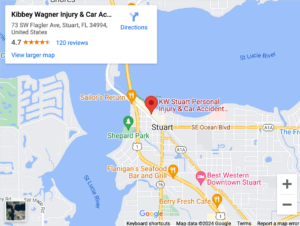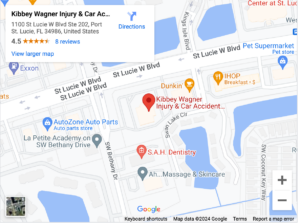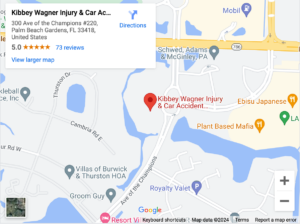
Drivers have always speculated about links between vehicle color and car accidents in Port St. Lucie, FL. Sometimes, this speculation is based on logic. Black cars might be more likely to be hit at night. In other situations, the suggested link arises from the personality of the driver, such as the idea that drivers who choose red cars tend to speed.
Theories about Port St. Lucie car color and crash risk often arise when attempting to shift blame from negligent drivers to crash victims. A Port St. Lucie car accident lawyer from Kibbey Wagner Injury & Car Accident Lawyers fights to hold negligent drivers responsible for the injuries they cause.
Contact our office at (772) 247-3374 to schedule a free consultation with our Port St. Lucie personal injury attorneys.
How Kibbey Wagner Injury & Car Accident Lawyers Can Help After a Car Accident in Port St. Lucie, FL

For over a decade, Kibbey Wagner Injury & Car Accident Lawyers has helped car crash victims in Port St. Lucie, Florida, stand up to insurance companies and at-fault drivers. Our attorneys have recovered over $500 million in financial compensation for the firm’s clients.
After you suffer a significant injury in a car crash caused by someone else’s negligent driving, our Port St. Lucie personal injury lawyers can assist you in the following ways:
- Meeting with you to discuss your case and explain your legal options
- Assembling the documents and evidence necessary to support your claim
- Working diligently to resolve your case without a lawsuit
- Litigating only if we cannot settle your case with the other driver’s insurer
Insurance companies may try to blame anything, including your car’s color, to avoid paying your claim. Contact us to schedule a free consultation with a Port St. Lucie car accident attorney and learn how we fight insurers for fair compensation for your injury-related costs and losses.
The Science Behind Car Color and Crash Risk
Courts typically only admit scientific evidence backed by reliable and repeatable scientific processes. Studies examining the effects of car color on collisions have generally reached conflicting conclusions. As a result, your lawyer has a strong argument against the admissibility of this evidence in court.
Some of the key studies about car color and collision statistics include:
University of Auckland Study
A study at the University of Auckland reviewed hundreds of crash records to determine whether automobiles of certain colors were more likely to be involved in crashes. After controlling for variables like driver age and alcohol consumption before the crash, the researchers determined that silver cars are always safer than cars of other colors.
Monash University Study
A study by researchers at Monash University in Australia reached exactly the opposite conclusion. After reviewing nearly a million crash records, the researchers concluded that red and silver cars are always more dangerous than cars in other colors.
University of Dayton Study
A study at the University of Dayton in the U.S. attempted to reconcile these studies and sought to correct a flaw in the prior research. Instead of considering all cars involved in crashes, the researchers only looked at the colors of vehicles whose drivers were found not at fault. In other words, the data in their analysis only used the victim’s car color, not the at-fault driver’s color.
Using this data, the researchers concluded that no single color is inherently more dangerous than any other color. Thus, silver is not always safer or more dangerous than other colors.
The University of Dayton study does contain one caveat. Certain colors may be more dangerous in certain situations. In other words, black cars might not always be more dangerous than white ones. However, black cars may be more difficult to see at night on an unlit road. Thus, they may have a higher crash risk in these narrow situations.
Liability for Crashes in Poor Visibility Conditions
If you can file a fault-based claim by escaping Florida’s no-fault system, you and your lawyer must prove that the other driver was negligent in order to recover compensation. Negligence means the other driver failed to exercise reasonable care under the circumstances.
In cases involving poor visibility, the circumstances are important. If the weather were misty and foggy, a reasonable driver would slow down, leave extra space between cars, or even park and wait for visibility to improve. Drivers engaging in distracted driving, DUI, or reckless behavior put others at higher risk, particularly at dangerous road intersections or highways. If a driver claims your gray car’s color caused them to rear-end you, your lawyer can say they should have adjusted their driving in the fog.
In other words, blaming the color of your car is simply a distraction. Instead of focusing on your car’s color, claims adjusters and jurors should give more weight to the other driver’s acts that were inappropriate for the conditions they encountered, whether they involved darkness, rain, or glare.
Contact Our Port St. Lucie Car Accident Lawyers for a Free Consultation
In most cases, blaming the color of your car is a distraction to frustrate you into giving up. Contact Kibbey Wagner Injury & Car Accident Lawyers for a free consultation. Our Port St. Lucie car accident attorneys can discuss how we stand up to the insurer to fight for your right to injury compensation.




